
Caln Township is a township in Chester County, Pennsylvania, United States. The population was 14,428 at the 2020 census. The township was founded by settlers from Calne, Wiltshire in England in 1714; the relationship between Calne and Wiltshire continues in the present since the two are sister cities. Caln is a township of the First Class, and the governing body is a Board of Commissioners. The township also owns Ingleside Golf Club and over 200 acres (0.81 km2) of green space and parks.

Downingtown is a borough in Chester County, Pennsylvania, United States, 33 miles (53 km) west of Philadelphia. As of the 2020 census, it had a population of 7,898. Downingtown was settled by European colonists in the early 18th century and has a number of historic buildings and structures.

West Chester is a borough and the county seat of Chester County, Pennsylvania, United States. Located within the Philadelphia metropolitan area, the borough had a population of 18,461 at the 2010 census. West Chester is the mailing address for most of its neighboring townships. When calculated by mailing address, the population as of the 2010 U.S. Census was 108,696, which would make it the 10th largest city by mailing address in the state of Pennsylvania.
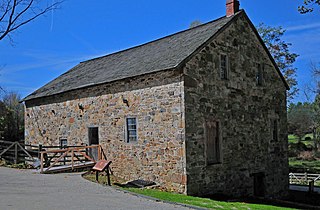
West Pikeland Township is a township in Chester County, Pennsylvania, United States. The population was 4,024 at the 2010 census.

Brandywine Creek is a tributary of the Christina River in southeastern Pennsylvania and northern Delaware in the United States. The Lower Brandywine is 20.4 miles (32.8 km) long and is a designated Pennsylvania Scenic River with several tributary streams. The East Branch and West Branch of the creek originate within 2 miles (3 km) of each other on the slopes of Welsh Mountain in Honey Brook Township, Pennsylvania, about 20 miles (32 km) northwest of their confluence.
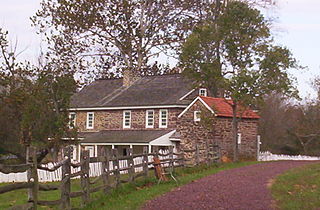
The Daniel Boone Homestead, the birthplace of American frontiersman Daniel Boone, is a museum and historic house that is administered by the Friends of the Daniel Boone Homestead near Birdsboro in Berks County, Pennsylvania. It is located on nearly 600 acres (2.4 km2) and is the largest site owned by the Pennsylvania Historical and Museum Commission. The staff at Daniel Boone Homestead interpret the lives of the three main families that lived at the Homestead: the Boones, the Maugridges and the DeTurks. The park is just off U.S. Route 422 north of Birdsboro in Exeter Township.

The Thomas Select School is a historic log building in rural Butler County, Ohio, United States. Constructed in 1810, the building has seen numerous uses, ranging from church to school to house. It has been named a historic site.

Hornby School is a one-room schoolhouse in Greenfield Township, Erie County in the U.S. state of Pennsylvania. The school was one of the ten similar schools constructed in Greenfield Township, and is one of only two one-room schoolhouses remaining in Erie County that are not heavily altered. The schoolhouse was constructed in 1875, and was originally called Shadduck School. Hornby School stayed in continuous operation as a school until 1956. It was restored and opened as the Hornby School Museum in 1984, and was listed on National Register of Historic Places in 2008.

The Newlin Mill Complex, also referred to as The Newlin Grist Mill, is a water-powered gristmill on the west branch of Chester Creek near Concordville, Pennsylvania built in 1704 by Nathaniel and Mary Newlin and operated commercially until 1941. During its three centuries of operation, the mill has been known as the Lower Mill, the Markham Mill, the Seventeen-O-Four Mill and the Concord Flour Mill. In 1958 the mill property was bought by E. Mortimer Newlin, restored and given to the Nicholas Newlin Foundation to use as a historical park. Water power is still used to grind corn meal which is sold on site. The park includes five historical buildings, which were added to the National Register of Historic Places in 1983, and 150 acres (61 ha) of natural woodland.
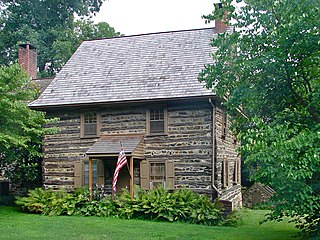
The Harlan Log House, also known as "The Log House," was built about 1715 by Joshua Harlan, is a well-preserved example of an English-style log cabin near Kennett Square, in Kennett Township, Chester County, Pennsylvania, United States. It is about a half mile west of the hamlet of Fairville. Joshua Harlan was the son of George Harlan, who arrived in Pennsylvania in 1687. Joshua was born in 1696 and was the cousin of the George Harlan, who built the Harlan House, about 12 miles north about 1724. Both houses are listed in the National Register of Historic Places.

C. A. Nothnagle Log House, also known as Braman-Nothnagle Log House, is a historic house on Swedesboro-Paulsboro Road in Gibbstown, New Jersey and is one of the oldest log houses in the United States.

Stephenson–Campbell House, also known as the Stephenson–Campbell Property and the Stephenson Log House, is a historic site in Cecil, Pennsylvania containing four contributing buildings. Included are a 1778 log house, a 1929 Sears and Roebuck Company mail order bungalow style house, a 1929 spring house, and a 1928 garage. The log house is 16 feet by 34 feet, with several additions totaling about 1360 square feet. The log house is one of the few pre-1780 log houses still standing in Western Pennsylvania, and the only known example of a single story private home still extant in the area.

The Lower Swedish Cabin is a historic Swedish-style log cabin which is located on Creek Road in the Drexel Hill section of Upper Darby, Pennsylvania, along Darby Creek. The cabin may be one of the oldest log cabins in the United States and is one of the last cabins built by the Swedish settlers that remains intact.
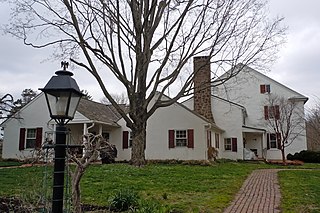
River Bend Farm is a historic farm located in East Coventry Township, Chester County, Pennsylvania in a bend of the Schuylkill River near Pottstown. The farm house is a good example of early Chester County construction techniques, being built with stuccoed stone walls and pegged rafters. The farm was owned, but not lived in, by Michael Hillegas, the first Treasurer of the United States. It was also owned by members of the Joshua family political dynasty.

Shelter House is a historic home located in Emmaus, Pennsylvania. Constructed in 1734, it is believed to be the oldest continuously occupied building structure in both Lehigh County and the Lehigh Valley and among the oldest still-standing building structures in the U.S. state of Pennsylvania.

The Lapp Log House, also known as the Hopper Log House, is an historic, American home that is located in East Whiteland Township, Chester County, Pennsylvania.
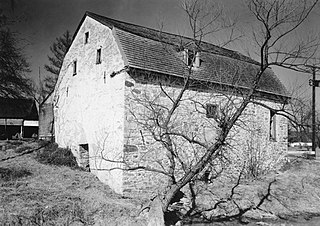
The Roger Hunt Mill is an historic, American grist mill complex that is located in Downingtown, Chester County, Pennsylvania.

East Lancaster Avenue Historic District is a national historic district located in Downingtown, Chester County, Pennsylvania. The district includes 121 contributing buildings and 1 contributing structure in Downingtown. The buildings include a number of notable examples of Georgian style dwellings dated to the early- to mid-18th century. Later notable dwellings are examples of the Federal and Victorian styles. Located in the district and separately listed are the Downingtown Log House and General Washington Inn.
Van Leer Cabin, is a historic cabin and one of the last historical dwellings in Tredyffrin Township, Pennsylvania. It still stands on the grounds of Conestoga High School.

Ivy Cottage is a historic residence located in Exton, a census-designated place in West Whiteland Township, Chester County, Pennsylvania. Built in 1799 by politician and soldier Richard Thomas, the cottage started out as a plain stone farmhouse in the double-door Georgian style. It underwent extensive renovations and embellishments in the Queen Anne style in 1881 followed by an award-winning restoration in 2019. It was listed on the National Register of Historic Places on November 9, 2018.
























